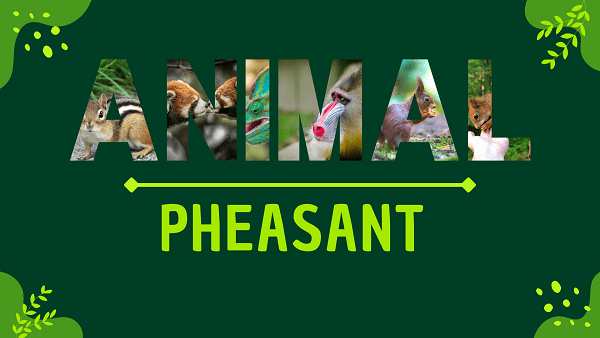Pheasant | Facts, Diet, Habitat & Pictures
Home » Animals » Pheasant | Facts, Diet, Habitat & Pictures
Pheasant Overview
Appearance
Pheasants are striking birds known for their colorful plumage. They have long, elegant tails with distinctive markings, and their bodies are adorned with iridescent feathers. The males pheasant called roosters or cocks, are particularly vibrant, displaying a combination of vivid hues such as green, red, and gold.
Females, called hens, are less flamboyantly colored, typically featuring brown or mottled patterns that provide effective camouflage. Pheasants have strong legs, allowing them to run swiftly on the ground, and their striking appearance makes them popular in aviculture and as game birds.
Origins And Evolution
Pheasants, members of the Phasianidae family, have an extensive evolutionary history dating back millions of years. They originated in Asia during the Late Miocene epoch. Fossil records indicate their presence in Europe, Asia, and North America during various geological periods.
Pheasants are part of the order Galliformes, which includes other game birds like quails and chickens. Over time, they have diversified into numerous species and subspecies, each adapted to specific habitats and climates.
Their remarkable plumage and behavior have been shaped through evolutionary processes, making them an emblematic group of birds in both their native and introduced ranges.
Today, pheasants are famous for their beauty and playing important roles in ecosystems and as game birds in various parts of the world.
Behavior and Lifestyle
Pheasants are ground-dwelling birds known for their terrestrial behavior. They are primarily diurnal, meaning they are active during the daytime. Pheasants are omnivorous, foraging for a wide range of food, including seeds, insects, and plant matter.
They are known for their distinctive mating rituals, which often involve elaborate displays by the males to attract females. Pheasants are typically social birds, often forming small flocks, especially during the non-breeding season, but they can also be solitary when nesting or during certain times of the year.
Pheasant Scientific Classification
- Kingdom: Animalia (Animals)
- Phylum: Chordata (Chordates)
- Class: Aves (Birds)
- Order: Galliformes (Gallinaceous Birds)
- Family: Phasianidae (Pheasants, Quails, Partridges, and Allies)
Pheasant Locations
- Asia
- Europe
- North America
- Africa
- South America
- Oceania
- United States
- China
- India
- United Kingdom
Fast Facts
- Name: Pheasant
- Scientific Name: Phasianus colchicus
- Habitat: Woodlands, Farmlands
- Diet: Omnivorous, Seeds
- Physical Features: Colorful plumage
- Nocturnal: No, Diurnal
- Solitary: Social, Ground-dwelling
- Unique Order: Galliformes, Phasianidae
- Lifespan: 3-5 years
- Conservation Status: Varies, Least Concern
- Fun Facts: Elaborate Courtship, Gamebird
Physical Characteristics
- Color: Colorful plumage
- Skin Type: Feather-covered
- Top Speed: 8-10 mph
- Lifespan: 3-5 years
- Weight: Medium-sized
- Length: 2-3 feet
- Age of Sexual Maturity: 1 year
- Age of Weaning: N/A (precocial young)
Pheasant FAQs
Are pheasants native to North America?
No, pheasants are not native to North America. They were introduced to the continent and have become established in various regions.
Are pheasants good flyers?
Pheasants are capable of short bursts of flight but are primarily ground-dwelling birds and are popular for their strong flying abilities.
What is the typical lifespan of a wild pheasant?
In the wild, pheasants generally live for about 3 to 4 years, although their lifespan can vary depending on factors like predation and habitat.
Are pheasants territorial birds?
Yes, male pheasants can be territorial during the breeding season and may defend a specific area to attract females.
Why are pheasants popular in aviculture and hunting?
Pheasants are popular in aviculture for their striking appearance. They are also a sought-after game bird due to their challenging behavior and delicious meat.
Related:
- Tarantula
- Mackerel
- Mackerel
- Sea Stars
- Bird
- Amphibians
- Vertebrates
- Sand Dollars
- Barnacles
- Scallop
- Brittle stars
- Tilapia
- Carp
- Krill
- Catfish
- Grouper
- Calm
- Yak
- Yucatan Brown Brocket
- White-tailed Deer
- Uakari
- Utahraptor (Dinosaur)
- Qinghai Lake Naked Carp
- Qilian Shrew
- Qinling Panda
- Qacha’s Nek long-fingered Frog
- Red Fox
- Red Panda
- Rockhopper Penguin
- Salamander
- Snail
- Storks


